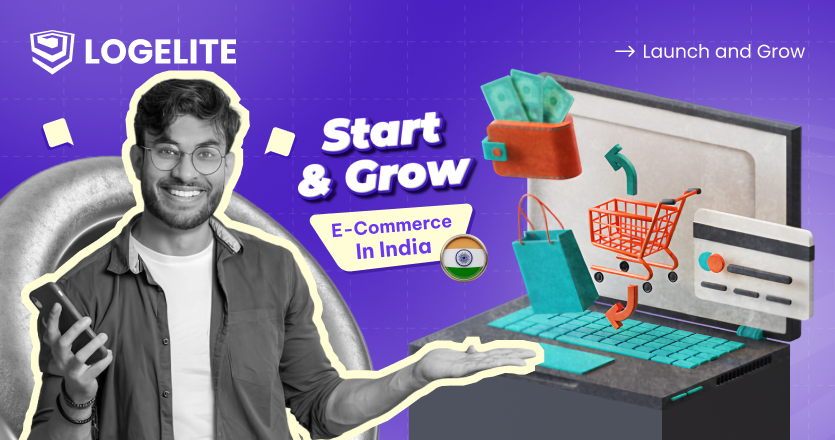
The e-commerce business is rapidly transforming the Indian markets. According to estimates, India will overtake the United States to become the second-largest e-commerce market by 2034, while the Indian e-commerce market is expected to reach ₹8,594 billion by 2029. This tremendous growth is not surprising, as there are more than 28 million e-commerce websites globally, and the market is estimated to reach $6.3 trillion by 2026. Source
What makes starting an e-commerce business especially attractive is its accessibility. Anyone can start their own e-commerce business for as little as $100 (domain and theme costs). Plus, with 23% of sales expected to happen online by 2025, the chances of success are very high. Source
In this comprehensive guide, we’ll explain the difference between e-commerce and e-business, examine different e-commerce business models, and outline the steps to building a profitable e-commerce store in India. Whether you want to sell directly to consumers or other businesses, we’ll explain in simple terms the key points of creating, marketing, and growing your online business in the fast-growing Indian market.
What is an e-commerce business?
In simple terms, e-commerce (electronic commerce) is the business of offering and providing solutions on virtual platforms. Unlike traditional retail, e-commerce is a digital marketplace that operates 24 hours a day, allowing customers to shop from anywhere and giving their companies access to international markets.
Definition and How It Works
E-commerce includes all online activities associated with trading products and services. This business includes displaying products on websites, processing orders and payments, managing inventory, arranging shipping, managing returns, and providing customer service. The process usually follows these steps:
- A business creates an e-commerce website or joins an online marketplace.
- Products and services are listed with descriptions and images.
- Customers browse, select items, and add them to a digital shopping cart.
- Payment is processed through a secure online gateway.
- The business receives and fulfills orders.
- Products or services are delivered to customers.
The majority of e-commerce traffic now comes from mobile devices, and mobile commerce accounts for nearly 57% of the e-commerce market. This means that nearly three out of every four dollars spent online today comes through mobile devices.
Difference between e-commerce and e-business
Many people use these terms interchangeably, but they represent different concepts:
| Aspect | E-commerce | E-business |
| Meaning | Performing online commercial transactions over the internet | Performing all types of business activities through the internet |
| Scope | Narrow concept and subset of e-business | The differences between e-commerce and e-business are as follows: Particulars |
| Activities | Selling/buying products, making payments, online ticketing, customer support | Supply chain management, procurement, customer education, email marketing, plus all e-commerce activities |
| Technology | Mainly requires websites and apps | Requires websites, ERPs, CRMs that connect different business processes |
| Context | More appropriate in Business to Customer (B2C) scenarios | The differences between e-commerce and e-business are as follows: Particulars |
| Coverage | Covers external/outward business processes | The differences between e-commerce and e-business are as follows: Particulars |
Essentially, e-commerce focuses specifically on online transactions, whereas e-business encompasses the entire digital presence of a business, including internal operations and strategies.
Key Components of an E-commerce Setup
A successful e-commerce business requires several integrated elements:
Content and user experience: This includes all of the website’s content (images, videos, product descriptions) and intuitive site navigation that makes browsing and shopping seamless.
Payment Processing: Secure payment gateways that protect customer financial information are crucial to building trust and completing transactions.
Order management: The logistics that happen after a purchase, including inventory management, packaging, and delivery.
Marketing & User Growth: Proven methods to draw potential buyers to your store and turn them into loyal customers.
Smart Supply Chain Management: Delivering excellent products at competitive pricing with guaranteed on-time arrival.
Security measures: Keeping customer data and payment information safe from cyber threats.
Mobile responsiveness: Since the majority of e-commerce traffic comes from mobile devices, your store should work perfectly on smartphones as well.
Scalability: A strong e-Commerce business system must handle increasing demand as your business grows, and maintain speed and reliability.
To stand out in today’s competitive online market, e-commerce businesses need flexible pricing models, customer loyalty initiatives, and strong quality control practices.
If you want to create your e-commerce store or need any help in your e-commerce business then you can contact us.
Types of E-commerce Business Models
Entrepreneurs who want to succeed online must first be aware of the various e-commerce business models. Each model defines how an e-commerce business engages with buyers and creates income in the online marketplace.
Business to Consumer (B2C)
The B2C model is the most popular part of e-commerce businesses, where businesses sell products or services directly to consumers. This model eliminates the commission agent between the company and the customer, allowing companies to do business directly with their customers. Amazon, which sells everything from books to electronics directly to buyers, is an example of this approach.
B2C transactions typically involve small purchase amounts and close sales quickly. Customers make most of the decisions, so the process is straightforward. B2C marketing often appeals to people’s emotions and highlights the social or personal benefits of a product rather than just its features
Several subtypes exist within the B2C framework:
- Direct sellers who market products through their platforms
- Online intermediaries that connect buyers with sellers
- Advertising-based businesses that monetize through ads
- Community-based platforms that target specific interest groups
- Subscription services that charge recurring fees for content or products
Business to Business (B2B)
A B2B e-commerce business involves transactions between businesses rather than directly with customers. In this model, manufacturers sell their products to wholesalers, wholesalers sell them to retail stores, or companies provide services to other companies. Today’s global B2B e-commerce market is huge and is worth over ₹210.95 trillion, accounting for about 14% of total B2B sales.
B2B transactions involve companies buying and selling goods or services to each other. Most of these involve large orders, such as buying goods in bulk. Such decisions are not made quickly, as many people and departments make decisions together. This makes the process lengthy and somewhat complex. B2B e-commerce business often involves negotiation of prices, setting specific terms, and building long-term relationships rather than one-time transactions.
Consumer to Consumer (C2C)
In C2C e-commerce business, i.e., consumer to consumer, common people buy and sell goods or services directly from each other. For this, online platforms (such as OLX or eBay) act as a bridge between buyers and sellers. On these platforms, people can sell their things or buy from others, without any association with a big company. This is the reason why this model is becoming very popular. The global C2C market was worth around ₹166.23 trillion in 2020, and it is estimated that by 2028, it will reach ₹410.09 trillion. This means that it is growing rapidly at a rate of about 12% every year. Source
Consumer to Business (C2B)
In the C2B (Consumer to Business) model, consumers provide their products, services, or content to companies. This is the opposite of the traditional model, where companies usually sell goods to consumers. In this model, consumers can decide on their terms and prices.
For example, freelancers on Upwork offer their services to companies. Similarly, influencers also provide promotional services to brands, which is a great example of the C2B model. Such a model gives consumers new opportunities to earn and companies a chance to get flexible services.
Multi-vendor vs. single-vendor model
In a single-vendor e-commerce store, only one seller sells products to customers. In this, the store owner has complete control over the brand and operations, but the range of products is limited.
On the other hand, on a multi-vendor platform, many sellers can sell their products in one place. This gives customers more options and also divides the business risk. However, maintaining the same quality and brand experience due to different sellers can be challenging.
Talking about earnings, the multi-vendor model runs on commission or subscription, while the single-vendor model depends directly on product sales. The right choice depends on your business goals and target market.
Benefits and impact of e-commerce business in India
E-commerce business is growing very fast in India. It is estimated that by 2026, India’s e-commerce market will reach US$200 billion. It is growing at a rate of about 25% every year. This is why today most entrepreneurs and businesses are moving towards this digital market.
Low cost and easy start
The biggest advantage of an e-commerce business is that it is not expensive to start. While opening a physical store involves expenses on rent, repairs, decoration, and a large inventory, the initial cost of an e-commerce store is very low. This is the reason why entrepreneurs with small budgets can also start it easily.
Along with this, e-commerce business is also scalable; that is, as the business grows, you can increase your products and market without spending much.
Reach more customers
Another big advantage of e-commerce business is that it breaks geographical boundaries. That is, your store is not limited to just one city or area. By 2024, 2.7 billion people worldwide will be shopping online, and this number can reach 3.5 billion by 2030.
The number of online shoppers is also increasing in India. About 70% of people in urban areas shop online, and the number of internet users is also increasing rapidly in rural areas. This is a great opportunity for all businesses, big and small, to reach new customer segments.
Impact on traditional businesses
Traditional shops have faced many challenges due to e-commerce businesses. In-store sales have declined, while online shopping has grown rapidly. But this does not mean that traditional businesses are over.
Many local shopkeepers are now using digital platforms such as inventory management, social media marketing, and providing pickup facilities for online orders. Grocery stores are also connecting with e-commerce apps. This hybrid model keeps them competitive in the digital era.
Importance of digital marketing
Digital marketing plays a big role in the success of e-commerce businesses. With the help of data and analytics, businesses can showcase personalized products and offers to their customers.
Social media platforms like Instagram and Facebook are no longer just a means for networking but also a means to promote products. Brands that have a strong social media presence have an average of 30% more sales. Apart from this, SEO, email marketing and influencer collaborations are also very important tools for e-commerce growth.
Step-by-step guide to starting an e-commerce business in India
Starting your own online store in India is easier than ever today. But if you don’t follow the right planning and steps, you may face problems later on. Here we will see step-by-step how to start an e-commerce business in India.
1. Choose the right product and niche
First of all, you have to decide which category of product you want to sell. Try to choose a product that is related to your interests and knowledge, and also has a demand in the market.
Use Google Trends or keyword tools to do research.
The niche should be small and targeted so that you can grow quickly with less competition.
2. Find a reliable supplier or manufacturer
Once the niche is decided, you will need a good supplier or manufacturer. Many cities in India are famous for different products like Tirupur (clothes), Moradabad (metal craft), and Jaipur (jewellery).
You can connect with verified suppliers through sites like IndiaMART, TradeIndia, or GlobalSources.
Always take samples and check their quality before entering into any deal.
3. Register the business and get GST
A GST number is a must for doing business online in India. No matter how much you earn, without GST, you cannot list products on marketplaces like Amazon and Flipkart.
For this, you need documents like PAN, business address proof, and bank details.
GST gives you legal recognition and also the benefit of claiming tax credit.
4. Choose your platform
Now you have to decide whether you will create your own e-commerce store or sell on a marketplace.
Creating your store: You can use platforms like Shopify, WooCommerce, or BigCommerce.
Sell on marketplaces: Platforms like Amazon, Flipkart, and Meesho are easy options.
Make sure the platform is mobile-friendly, easy to customize, and scalable.
5. Set up payment and delivery
The customer will trust only if the payment and delivery system is reliable.
For payment, you can choose gateways like RazorPay, PayPal, or Stripe.
For delivery, you can manage shipping yourself or use the logistics service of the marketplace.
Make sure the payment process is easy and secure; otherwise, 70% of customers abandon the cart midway.
By following these five basic steps, you can easily start your e-commerce business in India. After this, the next focus should be on marketing and winning the trust of customers.
How to market and grow your eCommerce business
Just building an online store is not enough. The real challenge is to reach customers and motivate them to buy again and again. For this, it is important to adopt the right marketing strategy. Let’s see how you can grow your eCommerce business:
1. Use SEO and content marketing
SEO is divided into two parts: on-page and off-page.
- On-page SEO: Increasing website speed, using the right keywords, and making it mobile-friendly.
- Off-page SEO: Building backlinks, guest blogging, and affiliate marketing.
Content marketing (blogs, guides, FAQs) is the best way to earn customer loyalty and bring leads inexpensively.
Click here for complete SEO information about.
2. Social Media and Influencer Marketing
Choose the platform based on your product:
- Instagram – Fashion and Visual Products
- Pinterest – Decor and Design
- Facebook – All types of audience
- YouTube – Demo and Reviews
Small influencers (nano/micro) often outperform big celebrities because their audience is more engaged.
Click here for complete information on social media promotion.
3. Ecommerce Advertising Strategies
- PPC Ads (Pay-Per-Click) show your product at the top of search results.
- Retargeting Ads bring back visitors who viewed the product but didn’t buy it.
Google data says that every ₹80-85 spent on PPC can bring in sales worth around ₹670+.
4. Email Marketing
Email marketing has the highest ROI (up to 36x).
Most effective emails:
- Cart Reminder Emails (for those who added a product but didn’t buy it)
- Welcome Emails (for new users)
- Product Launch / Seasonal Campaigns
Segment your email list based on customer preferences and behavior. This increases results by up to 40%.
5. Track performance with analytics
Key metrics:
- Conversion Rate
- Traffic Sources
- CTR (Click-Through-Rate)
- Bounce Rate
Tools like Google Analytics will help you figure out which channels are working best and which ones to invest more in.
If all these strategies are implemented consistently, your e-commerce business will not only attract customers but also achieve long-term growth.
Conclusion
E-commerce business has brought an extraordinary opportunity for Indian entrepreneurs today. It is not just a trend but the future of doing business. Recent statistics show that India’s e-commerce market is expected to reach ₹8,594 billion by 2029. Such a massive growth proves that digital retail will open new doors for business owners of all levels in the coming years.
E-commerce business is easier to start than traditional retail, as it requires relatively less capital. This is why anyone with determination and the right plan can make a mark in this field. Whether you adopt any model – B2C, B2B, C2C, or C2B, you will need a clear strategy, consistent efforts, and precise execution to achieve success.
Choosing a niche is the most important step in deciding the direction of the business. The right niche sets you apart from the competition and makes it easier to reach target customers. After this, you need to find reliable suppliers, do GST registration, and choose the right e-commerce platform for yourself. These basic steps lay a strong foundation for your business.
Marketing is the second pillar of this journey. It is not enough to build an online store; it is important to resort to SEO, content marketing, social media, and email campaigns to reach customers. Also, with the help of data analytics tools, you can track how effective your strategies are and improve them if needed.
Today, the shopping habits of consumers in India are changing. The inclination towards digital commerce is constantly increasing, especially after global circumstances like the pandemic. This change has forced traditional retailers to not rely only on offline and to adopt the digital medium as well. Many brands are now opting for a hybrid model, which combines both physical stores and online platforms.
The e-commerce journey may seem complicated at first. But if you break it down into smaller steps, the path becomes much easier. Its benefits, flexibility, rapid expansion potential, and huge customer reach inspire any ambitious entrepreneur to enter this field.
The future belongs to those businesses that embrace digital transformation and adapt with the times. By following the points mentioned in this guide, you can build a profitable and sustainable e-commerce business in the dynamic Indian market.
Key Takeaways
There is a huge potential for starting an e-commerce business in India. It is estimated that the market will reach ₹8,594 billion by 2029. What’s more, the startup costs are very low, making it an even easier and accessible option for new entrepreneurs.
Choose your niche strategically – Success in e-commerce business requires you to focus on a specific market that you specialize in. This will reduce competition and make it easier to reach the right customers.
Complete GST registration first – GST registration is a must for every e-commerce business in India, regardless of revenue. It is also mandatory to sell products on most online marketplaces.
Leverage multiple marketing channels – Don’t rely on just one marketing tool. Using a mix of SEO, social media, email marketing, and PPC ads will give you maximum reach. According to research, email marketing can have an ROI of up to 36:1.
Start with a proven platform – Building your own e-commerce platform can be costly and time-consuming at first. It is better to start with an established platform like Amazon, Flipkart, or Shopify to reduce technical difficulties and costs.
Track performance with analytics – Monitoring customer behavior, traffic sources, and conversion rates is important to understand the success of your business. This will help you channel your marketing spend and make better decisions.
The real secret to success in e-commerce business is to complete every step systematically, whether it is choosing the right niche or using marketing tactics accurately. Today, mobile commerce accounts for 57% of online sales, and 70% of urban Indians are already shopping online. In such a situation, India’s digital market offers the biggest opportunity ever for entrepreneurs.
Frequently Asked Questions
What are the most profitable e-commerce sectors in India?
Ans. E-commerce business is growing rapidly in India, and several sectors are generating the most profit. These include health and wellness products, sustainable and eco-friendly goods, fashion and accessories, handmade and customized goods, home decor and furniture, pet supplies, online education courses, and beauty and skincare products.
What are the main steps to start an e-commerce business in India?
Ans. To start any e-commerce business, it is important first to decide which model and which product you want to choose. After this, prepare a business plan, choose a brand name, and get registered. GST registration, selection of e-commerce platform or marketplace, payment gateway, and logistics setup also come under the important steps.
Is it possible to start an e-commerce business without money?
Ans. Yes, absolutely. Today, there are many e-commerce business models that can be started with minimal money. For example, options like drop-shipping, print-on-demand, and self-publishing allow you to start an e-commerce business without inventory or warehousing. This reduces the initial cost significantly.
What are the main types of e-commerce business models?
Ans. There are four main types of models in e-commerce: B2C (business-to-consumer), B2B (business-to-business), C2C (consumer-to-consumer), and C2B (consumer-to-business). Each model has its own target audience and structure.
How important is digital marketing for e-commerce success in India?
Ans. Digital marketing is the backbone of e-commerce business success. Strategies like SEO, content marketing, social media, and email marketing help reach customers and increase sales. For example, email marketing has an ROI of around 36:1, and businesses that have a strong social media presence have 32% more sales on average.












